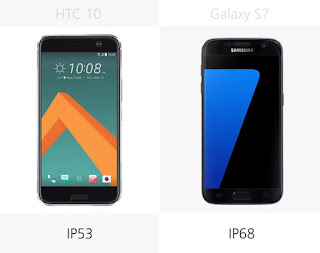There aren't any big differences in terms of chassis size, despite the HTC 10's bigger screen (more on that in a minute), though the Samsung Galaxy S7 is 13 percent thinner.
No big differences here either, with the HTC 10 weighing about 6 percent heavier than the Galaxy S7.
The HTC 10, like its predecessors, still has an aluminum unibody build, though it adds that striking chamfered edge this time around. The Galaxy S7, like its 2015 predecessor, has a glass and aluminum construction.
Screen size is close, but the display on the Samsung phone is 4 percent smaller than the one on its HTC rival.
The version of the GS7 sold in the US, China and Japan has the same processor as the HTC 10, while the rest of the world gets an octa-core Samsung Exynos 8990 chip.
Both these handsets come packed with an impressive 4 GB of RAM, substantial upgrades on the 3 GB in both the HTC One M9 and Samsung Galaxy S6.
In the US, you can only get these phones with 32 GB of internal storage, but our next section explains why.In other markets you might find larger options on offer.
You can expand the storage on both these phones with a microSD card up to 2 TB in size, so running out of room shouldn't be a problem.
There is a difference, though, in that the HTC 10 supports Android's Adoptable Storage while the Galaxy S7 doesn't. The feature makes external storage appear as internal storage to the OS.
Camera resolutions are identical, though we'll get on to subtler differences in a moment.
HTC has returned to its UltraPixel technology, which reduces the number of pixels compared to last year's HTC flagship, but makes them bigger – to allow in more light (and results in a much better overall camera this year).
Both phones have the same battery capacity, so any differences in battery life will come down to internal optimizations, software efficiency and engineering know-how. In our benchmark, the S7 had slightly better battery life.
HTC jumps to Qualcomm's latest Quick Charge technology, but Samsung sticks with last year's tech (possibly because of that Exynos processor).
Quick Charge 3.0's biggest advances come down to efficiency – don't expect much of an advantage in charging speeds over the 2.0 found in the S7.
Fingerprint sensors are here to stay, especially now that Android offers native support for the biometric ID tech. One notable difference in the two pill-shaped home buttons is that the S7 has a protruding/convex physical home button/sensor, while the HTC 10's sensor in a slightly concave capacitive home button/sensor.
Both phones also have capacitive back/recent apps keys flanking either side of the sensor, which gives them both full use of their screens (HTC's last two flagships used onscreen virtual navigation keys).
Samsung plays it safe with the tried and trusted microUSB (likely to keep things kosher with the same Gear VR that just launched in late 2015) but HTC jumps into the future by embracing the new reversible USB-C standard.
What these codes mean is that the HTC 10 has a certain amount of dust protection but can't be guaranteed to survive anything above a light, brief spray of water, while the Samsung Galaxy S7 can survive being five feet (1.5 meters) underwater for up to 30 minutes.
The Galaxy S7's full retail price varies a bit from carrier to carrier, but on average it's slightly cheaper than the HTC 10.






















0 comments:
Post a Comment